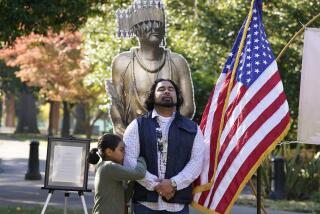The Acjachemen’s victory
On the chilly morning of the winter solstice last Sunday, the sun was just cresting the ridgeline of San Mateo Canyon as the Acjachemen talking circle started. Twenty or so people stood around a campfire. They passed a smoking bundle of dried white sage from hand to hand, then took turns speaking.
But rather than the cycle of seasons, the topic on everyone’s mind was that they had won, they who are not accustomed to winning. The ground on which they stood, site of an Acjachemen village that flourished for more than 8,000 years, would not be traversed by a turnpike. Not likely, anyway, after the federal government three days earlier rejected an appeal to build the Foothill South toll road through San Onofre State Beach.
The debate about the proposed toll road centered on potential damage to a favorite surfing spot and the fate of the endangered Pacific pocket mouse. Less mentioned was Panhe, the former village located within the state park just south of San Clemente, to which a number of Acjachemen -- called Juaneño by the Spanish -- can trace their lineage, thanks to the careful records kept by missionaries.
“This is our Mecca,” Rebecca Robles, one of those descendants, had told me on an earlier visit. “This is our temple.”
In 1769, the Portola expedition came across the 350 residents of Panhe. This is where the first baptism in California was performed, the site now marked with a large white cross.
It’s easy to see how Panhe’s importance, both historical and as a modern gathering place for Acjachemen ceremonies, might be overlooked, even though it is listed by the Native American Heritage Commission as a sacred site. The cross is the only obvious sign of previous human settlement. But a wealth of artifacts lies underground, along with untold numbers of human bones.
The Acjachemen lost efforts to preserve old settlements at Bolsa Chica in Huntington Beach and at a site near the San Juan Capistrano mission. And their decades-long quest to become a federally recognized tribe has so far failed, in part because they are split into four factions. (That failure in turn is a relief to municipal leaders who fear the group will erect its own objectionable development -- a casino.) The toll road was a rare and unexpected victory.
By the time the solstice ceremony concluded, the canyon was softly sunlit, newly green from recent rains and looking much like it must have for thousands of years. How many of us can stand on a spot and say that when Christianity was born, when the Ten Commandments were written, my ancestors were right here?
We admire civilizations for the man-made monuments that transform the landscape. The Pyramids. Stonehenge. The Acjachemen honor their ancestors for leaving no trace.
-- Karin Klein
More to Read
A cure for the common opinion
Get thought-provoking perspectives with our weekly newsletter.
You may occasionally receive promotional content from the Los Angeles Times.










